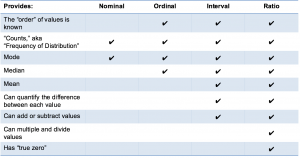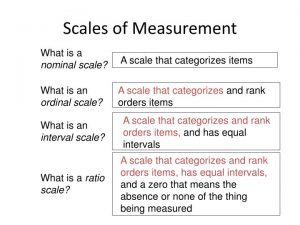
- Scales of measurement refers to the way which variables or the numbers are classified or categorized
- Each scale has the specific property and features
- There are basically four scales of measurement;
- Nominal scale (lowest level of measurement)
- Ordinal scale
- Interval scale
- Ratio scale (Highest level of measurement)
Table of Contents
1. Nominal scale
- Nominal scale deals with the non-numeric data that is with the categorical data
- It is a system of assigning number to the variable to label them only for identification and to distinguish them from each other. Example: Car-1, Buses-2
- It is a measure that simply divides objects or events into categories
- It is considered as the weakest tool of the measurement.
- It shows the quality of data.
- Here, categories are designated with names or numerals but ordering of categories is meaningless i.e. there is no order
- Examples: Gender, race, color preference, etc.
- Researchers may add the number or represent by number male=1 and female =2 but that number has no numerical value. These are nominal because they are numerical in name only
- The only mathematical operation that can be performed is count or say frequency.
1.1 Properties of nominal scale are:
- Mutually exclusive
- Categories are distinct and homogeneous
- They cannot be measured or ordered but can be counted
- Data can reflect that they are different from each other but cannot be ordered as smaller or greater.
2. Ordinal Scale
- It is system that ranks the value or data in order
- The gap between the variables are not quantified and doesn’t have to be same.
- Here a variable is categorized in different subgroups in ascending or descending order. However, the interval between the successive categories are unequal.
- A measure that divides objects or events into categories and arrange them in order of magnitude to provide ordered categories with unequal interval size.
- Used to interpret the relative positions.
- Example of the ordinal variable is the rating scale, Likert scale etc.
2.1 Characteristics of ordinal scale:
- It has unequal units
- It displays from highest to lowest by different measurement points
- It has no zero point i.e. it is arbitrary or absolute
- Interval size is unequal and unknown
2.2 Properties of ordinal scale:
- Mutually exclusive
- Categories are distinct and homogeneous
- They cannot be measured but can be counted and ordered/ranked
- Data can express that one is different from another and one is greater or smaller than the other. However, data cannot say that one is ‘X’ units or ‘X’times greater or smaller than the other.
- Examples: Academic performance: School-1, College-2, Bachelor-3, Masters-4
Disease severity: mild-1, moderate-2, severe-3
3. Interval Scale
- Interval scale is a system of assigning number to the variable to label them for identification and ranking based on a scale having equal interval size with arbitrary zero.
- Here, zero is arbitrary that allows measurement on either side of zero.
- Here, a variable is categorized in different subgroups in ascending or descending order and intervals between the successive categories are equal and constant.
- We can know bigger value and also how much bigger they are.
- Zero is not the lowest value there are point on scale which are below than it
- Examples include Celsius, Fahrenheit Temperature, IQ (intelligence scale), SAT scores.
- Here, 0 degree Celsius does not mean no temperature or no heat
- Likewise, 0 IQ does not mean no IQ
- Likewise, 64 degrees Fahrenheit is 32 units more than 32 degrees Fahrenheit but not twice as warm as 32 degrees Fahrenheit
- IQ 100 is 50 times more than IQ 50 but individual with IQ 100 is not two times intelligent than individual with IQ 50.
3.1 Characteristics of interval scale:
- It has equal units
- It has arbitrary (absolute) zero which is just a reference point
- Interval size is known, equal and constant
- Measurement is taken on both sides of zero
3.2 Properties of interval scale:
- Mutually exclusive.
- Categories are distinct and homogeneous.
- Can be measured and ranked/ordered.
- Data can show that one is different from other, one is greater or smaller than other, one is ‘X’ unit greater or smaller than other but cannot show that one is ‘X’ times greater or smaller than the other.
- Data can be added or subtracted but cannot be divided or multiplied.
4. Ratio scale
- Ratio scale is a system of assigning number to the variable to label them for identification and ranking based on a scale having equal interval size with absolute zero that allows measurement on only one side of zero.
- It is a top level of the measurement
- Here, a variable is categorized in different subgroups in ascending or descending order and intervals between the successive categories are equal and constant.
- Same as the interval scale except zero has the true value i.e. zero represent the absolute value
- All the mathematical operations are applicable in this scale.
- Examples include: weight, height, sales figures, ruler measurements, number of children.
- Here, weight 0 means no weight and weight 60 kgs mean it is 30 units more than 30 kgs and two times of 30 kgs.
4.1 Characteristics of ratio scale:
- It has equal units
- Has absolute zero
- Interval size is known, equal and constant.
- Measures on only one side of zero
4.2 Properties of ratio scale:
- Mutually exclusive.
- Categories are distinct and homogeneous.
- Can be measured and ranked/ordered.
- Data can show that one is different from other, one is greater or smaller than other, one is ‘X’ unit greater or smaller than other, one is ‘X’ times greater or smaller than the other.
- Data can be added, subtracted, multiplied or divided.
- Ratio of two numbers can be meaningfully calculated and interpreted
Comparisons of Four Scales of Measurement:

Furthermore, the comparison can also be seen in following aspects:
| Scales of Measurement | Arithmetic aspects that can be performed | Features/characteristics | Examples |
| Nominal scale | · Counting | · Unordered
· Can say one is different from other |
Religion, sex etc. |
| Ordinal scale | · Counting
· Ranking |
· Ordered category with unequal and unknown interval size | Economic status
academic performance etc. |
| Interval scale | · Counting
· Ranking · Measurement · Addition · Subtraction |
· Ordered category with equal and known interval size and arbitrary zero
· Can say one is different from the other · Can say one is greater or smaller than the other · Can say one is ‘X’ units greater or smaller than the other
|
Temperature, IQ score etc. |
| Ordinal Scale | · Counting
· Ranking · Measurement · Addition · Subtraction · Multiplication · Division |
· Ordered category with equal and known interval size and absolute zero
· Can say one is different from the other · Can say one is greater or smaller than the other · Can say one is ‘X’ units greater or smaller than the other · Can say one is ‘X’ times greater or smaller than the other
|
Body weight, height etc. |
References and for More Information:
http://lsc.cornell.edu/wp-content/uploads/2016/01/Intro-to-measurement-and-statistics.pdf
https://stattrek.com/statistics/measurement-scales.aspx
http://www.statisticshowto.com/nominal-ordinal-interval-ratio/
https://study.com/academy/lesson/scales-of-measurement-nominal-ordinal-interval-ratio.html
http://www.mnestudies.com/research/types-measurement-scales
https://onlinecourses.science.psu.edu/stat507/node/25/
https://cursos.campusvirtualsp.org/mod/tab/view.php?id=23154
https://www.cdc.gov/ophss/csels/dsepd/ss1978/lesson1/section8.html
http://www.open.edu/openlearn/science-maths-technology/science/health-sciences/epidemiology-introduction/content-section-3.1
